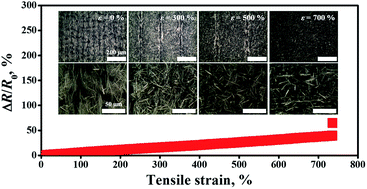Extremely stretchable conductors based on hierarchically-structured metal nanowire network
Abstract
Giant stretchability of an elastic conductor can potentially extend its application scope in the emerging field of stretchable electronics. We present a new class of extremely stretchable conductors based on a hierarchically-structured (HS) metal nanowire network that can be simply fabricated by a prestraining technique with a micro-prism-arrayed elastomeric substrate. The unique architecture of the HS conductor with aligned metal nanowires on a sloped surface of a micro-prism structure makes it possible to achieve ultra-stretchability of higher than 700% while ensuring electrical and mechanical robustness. The HS stretchable conductor shows highly stable and reversible electrical performance even under high (∼750%) and repetitive (100 cycle) strains.


 Please wait while we load your content...
Please wait while we load your content...